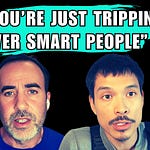Most founders wait until they have the perfect product. David Stepania didn’t.
He used a landing page, a few cold emails, and a clear vision—and convinced Rover, a billion-dollar company, to work with him. No code. No team. Just hustle, story, and a deep understanding of what people really need.
In this episode of ABCs for Building the Future, host Robert Ta sits down with David Stepania, founder of ThirstySprout, one of the fastest-growing companies in the U.S., to unpack:
How to build with nothing but belief and a landing page
Why community and content are underrated superpowers
The truths (and myths) about hiring, VCs, and scaling
What every founder should really focus on
1. Why You Don’t Need a Team to Get Started
David launched ThirstySprout with no engineers, no product, and no funding. His first move? A WordPress landing page and some outbound emails.
“I literally had nothing. No product. Just a landing page and some good copy—and I landed Rover.” – David Stepania
That first “yes” changed everything. David built a team for Rover by tapping friends in Eastern Europe and learning everything as he went.
Takeaway: Start small, sell the vision, and build after you have proof someone cares. Don’t wait until it’s perfect—validate first.
2. Lessons From Failure: How Losing $100K Built a Better Business
Before ThirstySprout, David lost $100,000 outsourcing a software idea that never took off. But it wasn’t wasted.
“We didn’t know how to build. And that’s when I realized—what if I could create a team people trust?” – David Stepania
That failure became fuel. He turned his pain into a business model: building trustworthy engineering teams for startups that don’t have time to waste money like he did.
Takeaway: Failures are tuition. If you learn the right lesson, they can lead to your best ideas.
3. The Fastest Path to PMF Isn’t Always a Product
David shares the hard truth: too many founders waste time coding instead of testing ideas. He’s seen companies die trying to build before selling.
“If you do it right, an MVP shouldn’t take more than 30 to 90 days.” – David Stepania
Instead of code, he focused on solving a problem: great startups need great developers fast. He solved it manually first, then scaled it.
Takeaway: Customer conversations are your MVP. Build what people want, not what you think they want.
4. What Founders Get Wrong About Hiring and VCs
One of David’s boldest takes is about hiring and fundraising:
“You don’t need a FANG engineer to build your MVP. You need someone who gets stuff done.” – David Stepania
He also warns about blindly following VC advice—especially when investors push startups to hire from their own networks.
“It’s not about control. It’s about solving real problems. Startups forget that.” – David Stepania
Takeaway: Hire for grit, not prestige. And always follow the problem, not the politics.
5. Why Content is the Founder Superpower of This Era
David is prolific on LinkedIn, with posts reaching millions—and it wasn’t luck. It was craft.
“English isn’t even my first language. But I study what makes people care—and speak from the heart.” – David Stepania
He treats LinkedIn like a product: experimenting with angles, writing with honesty, and using feedback to refine.
His tip for early founders? Start building your voice now. It's the cheapest way to win trust and lower CAC.
Takeaway: Your personal brand is your distribution engine. Use it to connect, not just promote.
Check Out David’s Links
Build your A-team with ThirstySprout
Check out his AI Newsletter and community, Homebase
Why Epistemic Me Matters
“How can AI understand us if we don’t fully understand ourselves?”
We solve for this by create programmatic models of self, modeling belief systems, which we believe are the basis of defense against existential risk.
In the longevity tech space, we create tools that meet users where they are, helping them make better decisions, form healthier habits, and align with their deepest values.
Can’t get enough? Check out the companion newsletter to this podcast.
Get Involved
Epistemic Me is building the foundational tools to make this vision a reality—and we’re doing it in the open. Here’s how you can join the movement:
Check out the GitHub repo to explore our open-source SDK and start contributing.
Subscribe to the podcast for weekly insights on technology, philosophy, and the future.
Join the community. Whether you’re a developer, researcher, or someone passionate about the intersection of AI and humanity, we want to hear from you. Email me anytime!
FAQs
Q: What is Epistemic Me?
A: It’s an open-source SDK designed to model belief systems and make AI more human-aligned.
Q: Who is this podcast for?
A: Entrepreneurs, builders, developers, researchers, and anyone who’s curious about the intersection of technology, philosophy, and personal growth. If you’ve ever wondered how to align AI with human values—or just how to understand yourself better—this is for you.
Q: How can I contribute?
A: Visit epistemicme.ai or check out our GitHub to start contributing today.
Q: Why open source? A: Transparency and collaboration are key to building tools that truly benefit humanity.
Q: Why focus on beliefs in AI?
A: Beliefs shape our understanding of the world. Modeling them enables AI to adapt to human nuances and foster shared understanding.
Q: How does Epistemic Me work?
A: Our open-source SDK uses predictive models to help developers create belief-driven, hyper-personalized solutions for applications in health, collaboration, and personal growth. Think of it as a toolkit for understanding how people think and making better tools, apps, or decisions because of it.
Q: How is this different from other AI tools?
A: Most AI tools are about predictions and automation. Epistemic Me is about understanding—building models that reflect the nuances of human thought and behavior. And it’s open source!
Q: How can I get involved?
A: Glad you asked! Check out our GitHub.
Q: Who can join?
A: Developers, philosophers, researchers, scientists and anyone passionate about the underpinnings of human beliefs, and interested in solving for AI Alignment.
Q: How to start?
A: Visit our GitHub repository, explore our documentation, and become part of a project that envisions a new frontier in belief modeling.
Q: Why open-source?
A: It’s about harnessing collective intelligence for innovation, transparency, and global community involvement in shaping belief-driven solutions.
P.S. Check out the companion newsletter to this podcast, ABCs for Building The Future, where I also share my own written perspective of building in the open and entrepreneurial lessons learned.
And if you haven’t already checked out my other newsletter, ABCs for Growth—that’s where I have personal reflections on personal growth related to applied emotional intelligence, leadership and influence concepts, etc.
P.S.S. Want reminders on entrepreneurship, growth, leadership, empathy, and product?
Follow me on..











